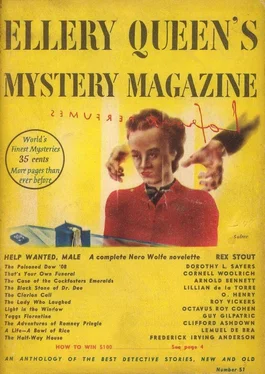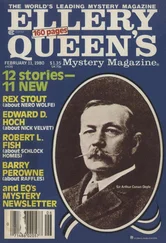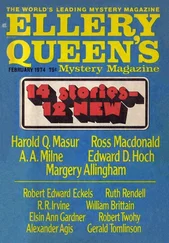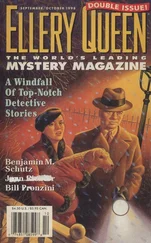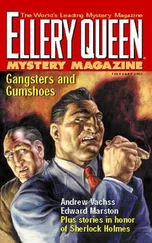Frederick Anderson - Ellery Queen's Mystery Magazine, Vol. 11, No. 51, February 1948
Здесь есть возможность читать онлайн «Frederick Anderson - Ellery Queen's Mystery Magazine, Vol. 11, No. 51, February 1948» весь текст электронной книги совершенно бесплатно (целиком полную версию без сокращений). В некоторых случаях можно слушать аудио, скачать через торрент в формате fb2 и присутствует краткое содержание. Город: New York, Год выпуска: 1948, Издательство: The American Mercury, Жанр: Классический детектив, на английском языке. Описание произведения, (предисловие) а так же отзывы посетителей доступны на портале библиотеки ЛибКат.
- Название:Ellery Queen's Mystery Magazine, Vol. 11, No. 51, February 1948
- Автор:
- Издательство:The American Mercury
- Жанр:
- Год:1948
- Город:New York
- ISBN:нет данных
- Рейтинг книги:3 / 5. Голосов: 1
-
Избранное:Добавить в избранное
- Отзывы:
-
Ваша оценка:
- 60
- 1
- 2
- 3
- 4
- 5
Ellery Queen's Mystery Magazine, Vol. 11, No. 51, February 1948: краткое содержание, описание и аннотация
Предлагаем к чтению аннотацию, описание, краткое содержание или предисловие (зависит от того, что написал сам автор книги «Ellery Queen's Mystery Magazine, Vol. 11, No. 51, February 1948»). Если вы не нашли необходимую информацию о книге — напишите в комментариях, мы постараемся отыскать её.
Ellery Queen's Mystery Magazine, Vol. 11, No. 51, February 1948 — читать онлайн бесплатно полную книгу (весь текст) целиком
Ниже представлен текст книги, разбитый по страницам. Система сохранения места последней прочитанной страницы, позволяет с удобством читать онлайн бесплатно книгу «Ellery Queen's Mystery Magazine, Vol. 11, No. 51, February 1948», без необходимости каждый раз заново искать на чём Вы остановились. Поставьте закладку, и сможете в любой момент перейти на страницу, на которой закончили чтение.
Интервал:
Закладка:
“Yes,” said Mrs. Wells. “My, these cobbles are terrible! Oh, why, look, Tom, those shops look like jewelry shops. Look, Tom, they are jewelry shops, every one of them!”
“Unh-huh,” agreed Mr. Wells. “All gyp jewelry shops. Lot of junk made up for the tourists, like Atlantic City. — Wonder what that statue is... Oh, why, it’s Benvenuto Cellini! Sure, don’t you remember in the guidebook, Bella? He had his shop out here on the bridge.”
When they had crossed the bridge, they came to a large shop the window of which was filled with jewelry. “There!” exclaimed Mrs. Wells, halting resolutely and pointing at the fifth necklace from the left. “There’s what I want, Tom, yes, just exactly! See, it’s the sardonyx one. It’s exactly...”
“S-h-h! Wait a minute, wait a minute!” muttered Mr. Wells out of the corner of his mouth. “Don’t go getting all excited! Don’t you see that man in there piping us off and getting set to gyp us? Keep on walking past and...”
“Oh, you make me sick!” declared Mrs. Wells. “I’m going in anyway.”
The Italian took the necklace out of the window and laid it on the counter. “Oh, yess!” he said. “Ees beootifoola teeng, I guarantee ees ver’ old. I guarantee ees make five a hone-dred years ago, een da quattrocento.”
“Hunh!” grunted Mr. Wells, picking it up as Mrs. Wells reached for it. “It looks pretty new to me. What are you asking for it?”
“Seex-a tosanda lira — all handa carve. Ver’ chip, sir!”
“Six thousand’s what you’re asking, but what will you take?” snorted Mr. Wells.
“Seex-a tosanda lira ees da price, sir. Ees ver’ chip! See, ees beootifoola stone, beooti...”
“Oh, shucks, talk like a business man!” urged Mr. Wells. “I s’pose you’re used to a lot of Americans who...”
The Italian bowed stiffly. “I am sorry,” he said. “Our price-a ees feex, we are estableesha house of feexa price.”
“Horse feathers!” declared Mr. Wells. “Come on, Mama, I told you this bird was a yegg. Now, down here in the little side streets...”
“Now, you shut up, Tom Wells!” said Mrs. Wells, blushing with embarrassment. “Six thousand wasn’t much for that and you know it.”
“Now, Bella, Bella, please!” begged Mr. Wells. “Just you leave this to me. I tell you all these birds on the main streets are gyps. Why, if that thing had been a genuine antique we couldn’t have bought it for ten thousand lira.”
“Well, it was exactly what I wanted. I’m going to remember that address — Via Benfratelli, Number 61.”
“Look!” exclaimed Mr. Wells. “Here’s a quaint little street. This is the kind of a place to find bargains. Let’s go down here.”
“Why, Tom, it’s only an alley. Phew, smell it? And those cobbles...”
“Oh, now, Ma, say, for goodness’ sake, what do you expect, Michigan Boulevard?”
They walked along an alley which twisted, turned, and finally came to a blind end. As they were about to go back, Mr. Wells peered into a doorway and saw an old man bending over a workbench on which were several pieces of jewelry.
“See there, Bella, look inside there!” he exclaimed triumphantly. “Come on!”
As they entered, the old man arose, bowed, and offered Mrs. Wells his chair.
“Good morning, lady and gentleman,” be beamed. “I speak-a good English.”
“Fine!” said Mr. Wells, glancing around the dark little shop and nodding at Mrs. Wells. “We were looking for a necklace, something kind of heavy gold — real antique of course — with sort of square sardonyx stones in it.”
“Ah, yes?” said the old man, wrinkling his forehead. “Ah, I do not know eef I have still such piece... pardon, please, I go see.” He hobbled into the gloom in the rear of the shop and disappeared behind a curtain.
“Now!” whispered Mr. Wells. “This is the kind of a place to snag off bargains! There’s no flash fronts or frock coats about this place. I told you we’d find something if...”
“Pardon,” said the Italian. “Here ees someteeng...”
“Ah-ha! There!” exclaimed Mr. Wells. “Look that one over, Bella!”
“Oh, why, it’s just like the other one!”
“Hunh — it’s just like the other one, but, boy, what a difference! You can tell that this one wasn’t made day before yesterday!”
“Yes,” said Mrs. Wells, trying it around her neck.
“Fine-a antique!” declared the old man, proudly. “I sell-a only da fine-a antique.”
“Yes,” repeated Mrs. Wells. “How much is...”
“What are you asking for it, brother?” broke in Mr. Wells. “I mean, what’ll you take, no fooling?” Once more the Italian wrinkled his forehead. “For thees lady, I maka special price,” he said. “Ten tosanda lira — ver’ chip!”
Mr. Wells winked at him and poked him in the ribs. “Yes, yes, go on — I’m listening!” he chuckled.
The old man shrugged his shoulders. “Ah-ha!” he laughed. “I see-a thees gentleman ees smart-a man. Nine-a tosanda five honed red?”
“I heard you the first time. Nine thousand!” said Mr. Wells, slapping him on the back and reaching for his wallet. “How about it?”
“Ah,” sighed the old man, shaking his head but smiling at Mrs. Wells. “Your gentleman ees ver’ smart-a man! But for you, lady, I say yes. I sell eet for nine-tosanda lira.”
“At-a-boy!” approved Mr. Wells. “Here’s your money, and now we’re all happy. Put it on and wear it home, Bella. Guess it was worth the walk and the sore feet, hey?”
“You walk-a far?” inquired the Italian sympathetically. “You like-a taxi for hotel, lady?”
“Oh, could you get one?” asked Mrs. Wells, looking out at the dismal alley.
“Yes. Please come-a thees way.” He led them to the rear of the room, drew aside the curtain, and ushered them into a bright and spacious and familiar jewelry store. “Here ees da fronta my shop,” he explained proudly. “Via Benfratelli, Number 61.”
The half-way house
by Frederick Irving Anderson [9] Copyright, 1922, by Crowell-Collier Publishing Co.
We are leafing through a copy of “ The American Magazine” dated May 1922. The magazine is chock-full of advertisements — full pages, half pages, and assorted “wee” ones. And it is interesting to note the names of the commercial products advertised nearly twenty-six years ago. We are told the virtues of Life Savers, Westclox, Ivory Soap, Campbell’s Soup, Robt. Burns Cigar, Dodge automobile, Palmolive Shaving Cream, Goodyear Tires, Remington Portable Typewriter, Squibb, Elgin Watches, Grape-Nuts, Western Electric, Edgeworth Tobacco, Sheetrock, Venus Pencils, McNally Maps, Florsheim Shoes, Fuller Brushes, Westinghouse, Ivor Johnson Bicycles, Carter’s Ink, Colt’s Fire Arms, Fleischmann s Yeast, Odo-ro-no, Listerine, “ Standard” Plumbing Fixtures, Swift’s Premium Hams and Bacon, Kodak, and many, many more including the perennial sets of Mark Twain, James Whitcomb Riley, and Conan Doyle.
After twenty-six years these products are more famous, more flourishing than ever. Indeed, from an advertising standpoint, this copy of “The American Magazine” might well have been published today. But what about the other contents of the magazine? The fiction, for example? Has that stood the test of time as ruggedly as the commercial trademarks? Well, here’s a story from “The American Magazine” of May 1922. Read it and judge for yourself. In our opinion Frederick Irving Anderson’s “ The Half Way House” is as undated as it was a quarter of a century ago. It too might have been first published today.
Shortly after the old chimney clock struck nine, Grinder, the jaunty dog combing burrs out of his stump tail by the fire, suddenly lifted his head and looked keenly at his master, Belden, the bridge builder, and his good friend, Armiston. The pair were poring over chess.
Читать дальшеИнтервал:
Закладка:
Похожие книги на «Ellery Queen's Mystery Magazine, Vol. 11, No. 51, February 1948»
Представляем Вашему вниманию похожие книги на «Ellery Queen's Mystery Magazine, Vol. 11, No. 51, February 1948» списком для выбора. Мы отобрали схожую по названию и смыслу литературу в надежде предоставить читателям больше вариантов отыскать новые, интересные, ещё непрочитанные произведения.
Обсуждение, отзывы о книге «Ellery Queen's Mystery Magazine, Vol. 11, No. 51, February 1948» и просто собственные мнения читателей. Оставьте ваши комментарии, напишите, что Вы думаете о произведении, его смысле или главных героях. Укажите что конкретно понравилось, а что нет, и почему Вы так считаете.
